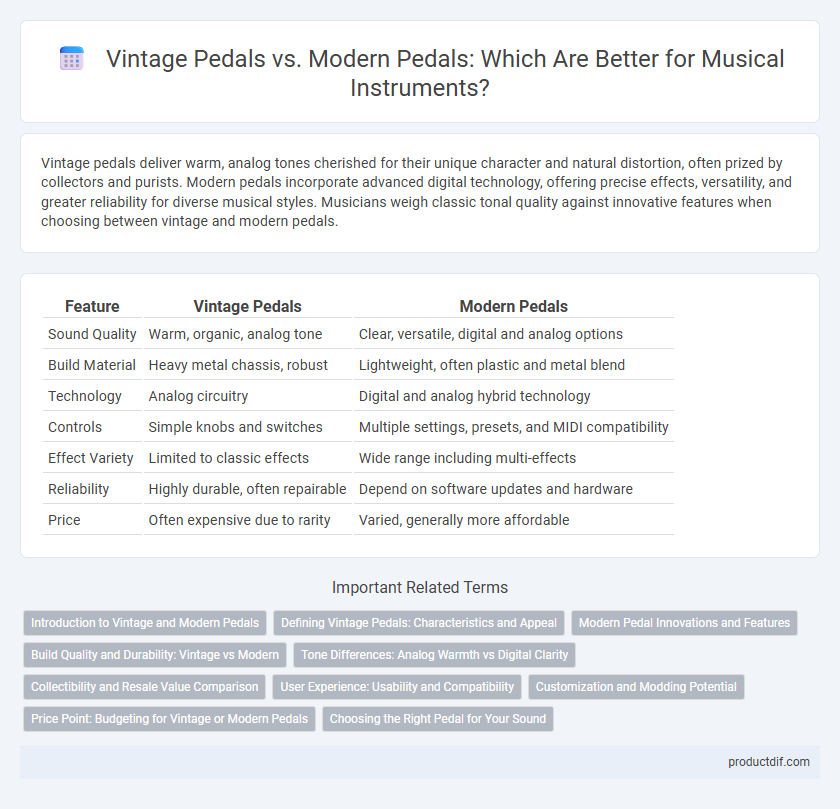Vintage pedals deliver warm, analog tones cherished for their unique character and natural distortion, often prized by collectors and purists. Modern pedals incorporate advanced digital technology, offering precise effects, versatility, and greater reliability for diverse musical styles. Musicians weigh classic tonal quality against innovative features when choosing between vintage and modern pedals.
Table of Comparison
| Feature | Vintage Pedals | Modern Pedals |
|---|---|---|
| Sound Quality | Warm, organic, analog tone | Clear, versatile, digital and analog options |
| Build Material | Heavy metal chassis, robust | Lightweight, often plastic and metal blend |
| Technology | Analog circuitry | Digital and analog hybrid technology |
| Controls | Simple knobs and switches | Multiple settings, presets, and MIDI compatibility |
| Effect Variety | Limited to classic effects | Wide range including multi-effects |
| Reliability | Highly durable, often repairable | Depend on software updates and hardware |
| Price | Often expensive due to rarity | Varied, generally more affordable |
Introduction to Vintage and Modern Pedals
Vintage pedals, often characterized by analog circuitry and classic tonal qualities, deliver warm, organic sounds favored in genres like blues and classic rock. Modern pedals incorporate digital technology, offering a broad range of effects, precise control, and enhanced durability suited for contemporary music styles. Musicians choose between vintage warmth and modern versatility based on their tonal preferences and performance needs.
Defining Vintage Pedals: Characteristics and Appeal
Vintage pedals are characterized by their analog circuitry, unique tonal warmth, and often handmade components that deliver a distinct sound signature prized by collectors and musicians. Their appeal lies in the organic, rich harmonics and subtle imperfections that create a more dynamic and expressive playing experience compared to the often precise but sterile output of modern pedals. These pedals typically feature simpler designs and robust build quality, contributing to their timeless aesthetic and enduring value in the music community.
Modern Pedal Innovations and Features
Modern pedals incorporate digital signal processing, offering customizable presets and multi-effects integration that vintage pedals lack. Advanced features include USB connectivity for firmware updates and seamless integration with digital audio workstations, enhancing workflow for guitarists. True bypass switching and improved noise reduction circuits ensure pristine sound quality and durability in contemporary pedal designs.
Build Quality and Durability: Vintage vs Modern
Vintage pedals often feature robust metal enclosures and hand-wired circuits that contribute to their renowned durability and reliability over decades. Modern pedals benefit from advanced manufacturing techniques and high-quality components, offering consistent build quality with improved weather resistance and compact designs. Both vintage and modern pedals deliver exceptional longevity, but vintage units may require more maintenance due to aging parts, while modern pedals excel in precision engineering and material innovation.
Tone Differences: Analog Warmth vs Digital Clarity
Vintage pedals are prized for their analog warmth, producing rich, organic tones with natural harmonic distortion that seamlessly blend with guitar signals. Modern pedals often emphasize digital clarity, offering precise, noise-free effects and a broader palette of sounds, including emulations of classic analog tones. Musicians seeking authentic vintage character typically favor analog circuits, while those prioritizing versatility and consistency prefer digital pedals.
Collectibility and Resale Value Comparison
Vintage pedals often command higher collectibility due to their unique analog circuitry and historical significance, making them highly sought after by musicians and collectors. Modern pedals, while incorporating advanced digital features and versatility, typically depreciate faster but maintain steady resale value through brand reputation and continuous innovation. Limited production runs and original components significantly impact the long-term resale value of both vintage and modern pedals.
User Experience: Usability and Compatibility
Vintage pedals offer a distinct user experience with straightforward controls and rugged, analog circuitry favored by musicians seeking classic tones, though they may lack compatibility with modern gear and require more maintenance. Modern pedals often provide enhanced usability through digital interfaces, programmable settings, and seamless integration with current amplifiers and multi-effects systems, appealing to players who prioritize versatility and ease of use. Compatibility remains a key factor, as modern pedals typically support wider voltage ranges and diverse connectivity options, ensuring smoother integration into contemporary pedalboards.
Customization and Modding Potential
Vintage pedals often feature simpler circuit designs that offer straightforward sound characteristics, appealing to purists who prefer authentic analog tones. Modern pedals incorporate advanced digital components and versatile control parameters, providing extensive customization options and easier integration with external modulation tools. Modding potential is higher in vintage pedals due to their open, less complex layouts, enabling enthusiasts to tweak components for unique tonal variations.
Price Point: Budgeting for Vintage or Modern Pedals
Vintage pedals often carry a premium price due to their rarity, brand legacy, and collectible status, with models from the 1960s and 1970s frequently selling for several hundred to thousands of dollars. Modern pedals provide more budget-friendly options, utilizing advanced technology and mass production that lower manufacturing costs, typically ranging from $50 to $300. Buyers must assess their budget against the value of authentic vintage tone versus the innovation and affordability found in contemporary pedal designs.
Choosing the Right Pedal for Your Sound
Vintage pedals deliver classic, warm tones favored by blues and rock guitarists, with analog circuits producing natural overdrive and distinct character. Modern pedals offer versatile digital effects and precise sound shaping, catering to genres requiring clarity and a wide range of sonic textures. Selecting the right pedal depends on your musical style, desired tone authenticity, and performance needs, balancing vintage warmth against modern flexibility.
Vintage pedals vs Modern pedals Infographic

 productdif.com
productdif.com